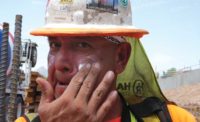Microscopic nanoparticles are part of the mix in nearly 600 construction products. The particles add strength, durability and other desired characteristics.
But many construction workers lack a basic awareness that these super-small particles are in the materials and the unresolved health issues that they pose, a new study finds.
Just quarter of the workers surveyed knew about the use of these micro-materials in construction materials.
The State Building and Construction Trades Council of California surveyed 253 workers in 24 trades across the state, from insulators to iron workers to carpenters and plumbers.
Funded by the Center for Construction Research and Training, or CPWR, the survey found that nearly 20% of the workers had never heard of nanotechnology or nanoparticles, while just a quarter of the workers surveyed knew about their use in construction materials.
Yet when given a list of “nano-enabled” products, 44% of the workers surveyed were able to pick out items on the list.
A vast range of construction materials now contain nanomaterials. Among them are wood floor planking, concrete and cement, drywall, caulkin, roofing and weld overlays, according to CPWR.
And researchers and workplace health specialists are scrambling to keep up and discern the potential hazards involved in inhaling or absorbing them.
“Development of engineered nanomaterials is rapid and outpaces government efforts to monitor and research them,” note the researchers on the report by the state building trades council, who also did a number of interviews with California regulators. “Also, these materials are rapidly being incorporated into many different products, making it nearly impossible to track them all.”
Even so, the National Institute for Occupational Health and Safety recently released more guidance designed to help employers protect workers exposed to nanomaterials. The agency defines nanomaterials as having one dimension smaller than 100 nanometers.
Nanomaterials are “primarily used in surface coatings, concrete, window glass, insulation and steel,” a pair of researchers from Loughborough University in the U.K. wrote earlier this year, describing their research in a trade publication, Planning and Building Control Today.
There is no risk when anomaterials are “embedded in a solid, stable structure,” but that can change when “exposed to nanoparticles or nanofibres in the form of dusts or aerosols – which can occur during construction or demolition,” write the Loughborough University researchers, Professor Alistair Gibb and Dr. Wendy Jones
The difficulty can be in figuring out whether different products use particularly hazardous nanomaterials with the potential to infiltrate the lungs, such as Carbon Nanotudes. Just knowing there are CNTs in a construction product is not enough. CNTs whose form is “long, straight and stiff,” are the most hazardous, yet others can be “short and curly” and present much less of a threat Gibb and Jones notes.
Still, the greatest knowledge gap as it relates to nanomaterials is on the front lines of the construction industry, notes the CPWR report: “Nanotechnology: Assessing Awareness and Training Needs Among California Construction Trades.”
Insulation workers were some of the best educated on nanomaterials, including both how they are used in their field and their potential risks, a knowledge that comes hard experience in decades past based on devastating health issues caused by asbestos and silica.
“The insulators are operating under the shadow of asbestos and being told it’s a great new material and its safe,” said Laura Boatman of the California building trades council, who wrote the report with Debra Chaplan, a colleague at the building trades council.
The highest awareness was shown by electricians, pipefitters/steamfitters, roofers/waterproofers, iron workers, plasterers, plumbers, cement masons, glaziers, sheet metal workers and tile layers/finishers.
The researchers interviewed workers ranging from union business managers to foremen to journeymen and a senior risk consultant.
Only 2% of those surveyed had taken or been offered any training related to nanomaterials, and that training was focused on the use of the product, not how to use it safely. The one exception was a carpenter who had plans to attend an upcoming nanomaterial safety training session put on by his union in Las Vegas.
Not On Radar Screens
“It has never come up,” Boatman said. “It’s not on people’s radar screens in terms of safety training.”
Bruce Lippy, director of safety research at CPWR, said one concern about the use of nanomaterials in construction is that their very design makes it easier for the body to absorb. Their small size allows gives microscopic materials a larger amount of surface area. Once in the body, nanomaterials may have an easier time infiltrating various internal barriers that would stop other materials and making their way into the brain.
But given the lack of information about just how nanomaterials are used in construction products, it can be hard for workers and contractors to have the kind of data they need to take the necessary precautions
Safety sheets put out by companies that make products don’t list which ones which ones involve nanomaterials, he noted. “They will list ingredients but you will have to guess which ones are nano.”






